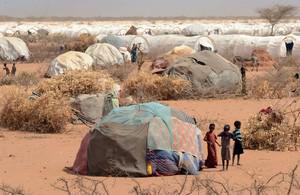Food securityFamine: Nearly 1.4 million children at risk of death in Nigeria, Somalia, South Sudan, and Yemen
Famine is looming in north-east Nigeria, Somalia, South Sudan, Yemen, and beyond, as nearly 1.4 million children are at imminent risk of death from severe acute malnutrition this year. Some 22 million children are hungry, sick, displaced, and out of school due to war, conflict and drought. They now face the risk of death from starvation, but also from preventable diseases like cholera and measles, which cause severe diarrhea and dehydration. This crisis is largely human-made. Scorched earth tactics by conflicting parties are destroying crops and critical infrastructure like health facilities. Heavy fighting is forcing farmers to abandon their fields, while blocking humanitarian access to people in desperate need of food aid and clean water.

Children in famine-driven refugee camp // Source: theconversation.com
Famine is looming in north-east Nigeria, Somalia, South Sudan, Yemen, and beyond, as nearly 1.4 million children are at imminent risk of death from severe acute malnutrition this year.
Some 22 million children are hungry, sick, displaced, and out of school due to war, conflict and drought. They now face the risk of death from starvation, but also from preventable diseases like cholera and measles, which cause severe diarrhea and dehydration.
UNICEF says that the risk of famine is not limited to these four countries. As violence, hunger, and thirst force people to move within and across borders, malnutrition rates will continue to soar in neighboring countries as well.
This crisis is largely human-made. Scorched earth tactics by conflicting parties are destroying crops and critical infrastructure like health facilities. Heavy fighting is forcing farmers to abandon their fields, while blocking humanitarian access to people in desperate need of food aid and clean water.
As families flee their homes, children have no access to health and nutrition services, clean water, or adequate sanitation and hygiene – putting them at greater risk of malnutrition. Diseases are spreading rapidly in crowded sites for displaced people. And drought is further exacerbating food crises in parts of Africa, particularly Somalia and the Horn of Africa.
“Six years ago, at least 100,000 children died of a famine in the Horn of Africa because the world did not act soon enough,” UNICEF says. “Children cannot wait for yet another famine declaration – the time for action is now. We must reverse famine where it exists, and prevent famine where it looms.
“UNICEF calls on all parties to these ongoing conflicts to stop human rights violations and allow unconditional humanitarian access to all people in need.”
The relief agency notes that it currently has teams on the ground in all of the affected countries. Urgent funding is needed to enable our teams to scale up life-saving interventions. “We need close to $255 million to provide children with food, water, health, education and protection services for just the next few months,” UNICEF says.
North-east Nigeria
In north-east Nigeria’s conflict-affected states of Adamawa, Borno and Yobi, the number of children with severe acute malnutrition is expected to reach 450,000 by the end of the year. According to FEWS Net, the famine early warning system that monitors food insecurity, famine likely occurred last year in previously inaccessible areas of Borno state, and it is likely ongoing in other
